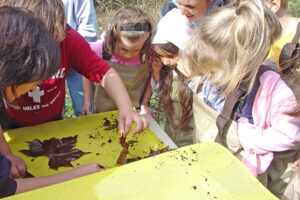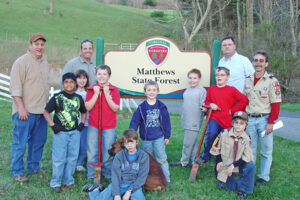The Matthews State Forest was a gift to the Commonwealth from the late Judge Jack Matthews. The judge’s vision for his property was to create a state forest “to provide for the scientific, educational, recreational, and research needs for Southwest Virginia’s children and the public.”
Educational Opportunities
The Virginia Department of Forestry (VDOF) invites all educators to make use of this unique and valuable resource. Teachers and group leaders are welcome to schedule educational trips to the state forest.
Self-Guided Learning
Matthews State Forest covers 566 acres of managed woodlands and open areas. Educators may create their own learning experiences using the 1.3-mile forest education trail, 8 miles of mountain bike/hiking trails, or 4.5 miles of forest roads that are closed to vehicles.
Formal Educational Programs
VDOF staff offer formal field experiences with SOL-correlated lessons on a variety of educational themes. Most of these topics can be adapted to suit different age groups. Forest learning hikes are also available.
Many use Project Learning Tree activities while visiting the Matthews State Forest.
- Educational programs are available to any group from pre-kindergarten to adult
- Teachers can request lessons covering specific topics or standards of learning (SOLs).
- Participants in educational experiences at the Matthews State Forest will increase their knowledge of one or more of the following topics:
- Basic tree biology, physiology, and taxonomy
- Tree identification
- Physical and growth features
- Needs of trees
- Basic forest ecology and forest types
- Appalachian ecosystems
- Succession and competition
- Characteristics of pine, upland hardwood, and bottomland/riparian hardwood forest types
- Other forest components (plants, soils, animals, etc.)
- Virginia’s forest wildlife
- Common species of wildlife in Southwest Virginia
- Food webs and other interactions
- Habitat requirements
- Focus on specific species
- Forests as renewable resources that produce many products and benefits
- Forest products
- Other benefits. See # 3, 5, 6
- Forest roles in maintaining the quality of water, air, and other environmental aspects
- Watershed / water quality /flood control
- Biodiversity of plants and animals
- Soil conservation / quality
- Air quality / carbon sequestration
- Climate (local to global)
- Pollination
- Water
- Water quality testing
- Aquatic life/ macro-invertebrates
- Watersheds
- Reasons and methods for managing forests
- Timber, paper, and other consumer goods
- Pine silviculture
- Hardwood silviculture
- Harvest systems (even and uneven-aged)
- Forestry Best Management Practices
- Intermediate prescriptions (prescribed fire, release, thinning, etc.)
- Site preparation and planting
- Historical uses of forest resources in Virginia
- Traditional uses and products
- Other topics
- Issues and factors that affect Virginia’s forests
- Invasive species
- Wildfire
- Pollution
- Land use changes
- Climate change
- Current issues of local or global importance (subject to change)
- Forestry and Natural Resource Career Skills
- Scientific methodology (observation, inquiry, data collection, etc.)
- Forestry skills (tree measurement, ID, stand assessment, etc.)
- Specific topics unique to the Matthews property
- Efforts to restore diminished species (e.g. American chestnut, shortleaf pine, bobwhite quail)
Additional Resources
- Read more about Matthews State Forest.
- Read more about educator resources.
Contact Us
For more information or questions, e-mail us or use our contact form.



